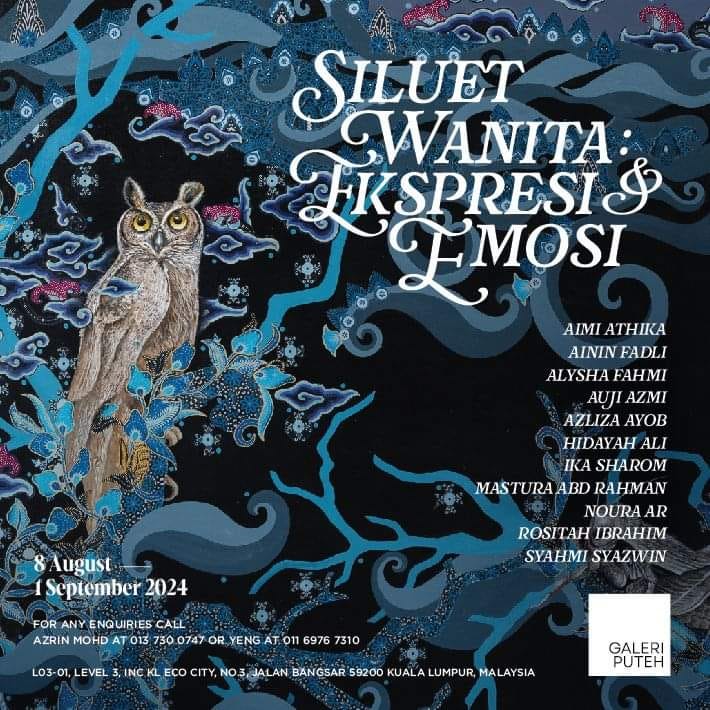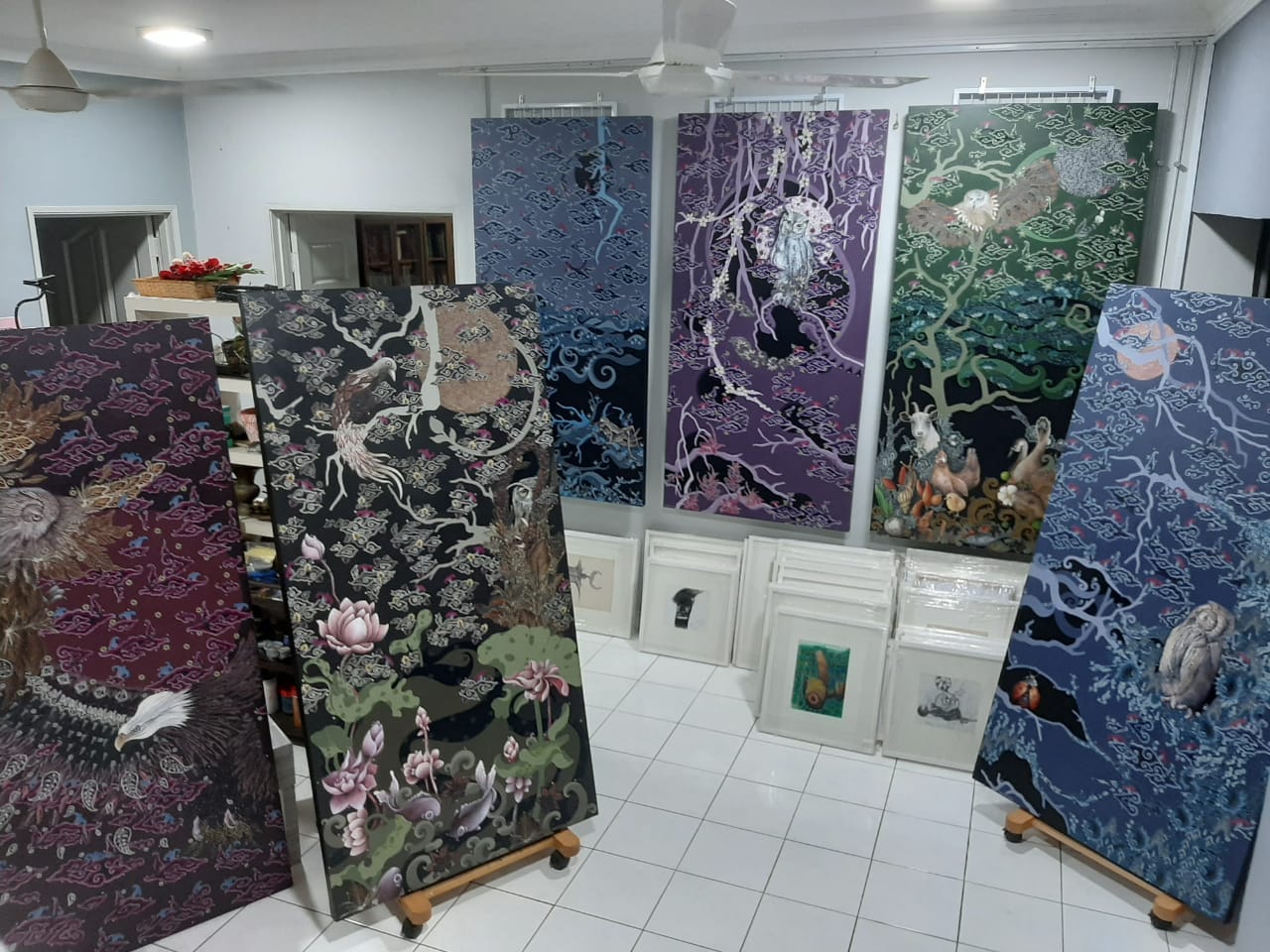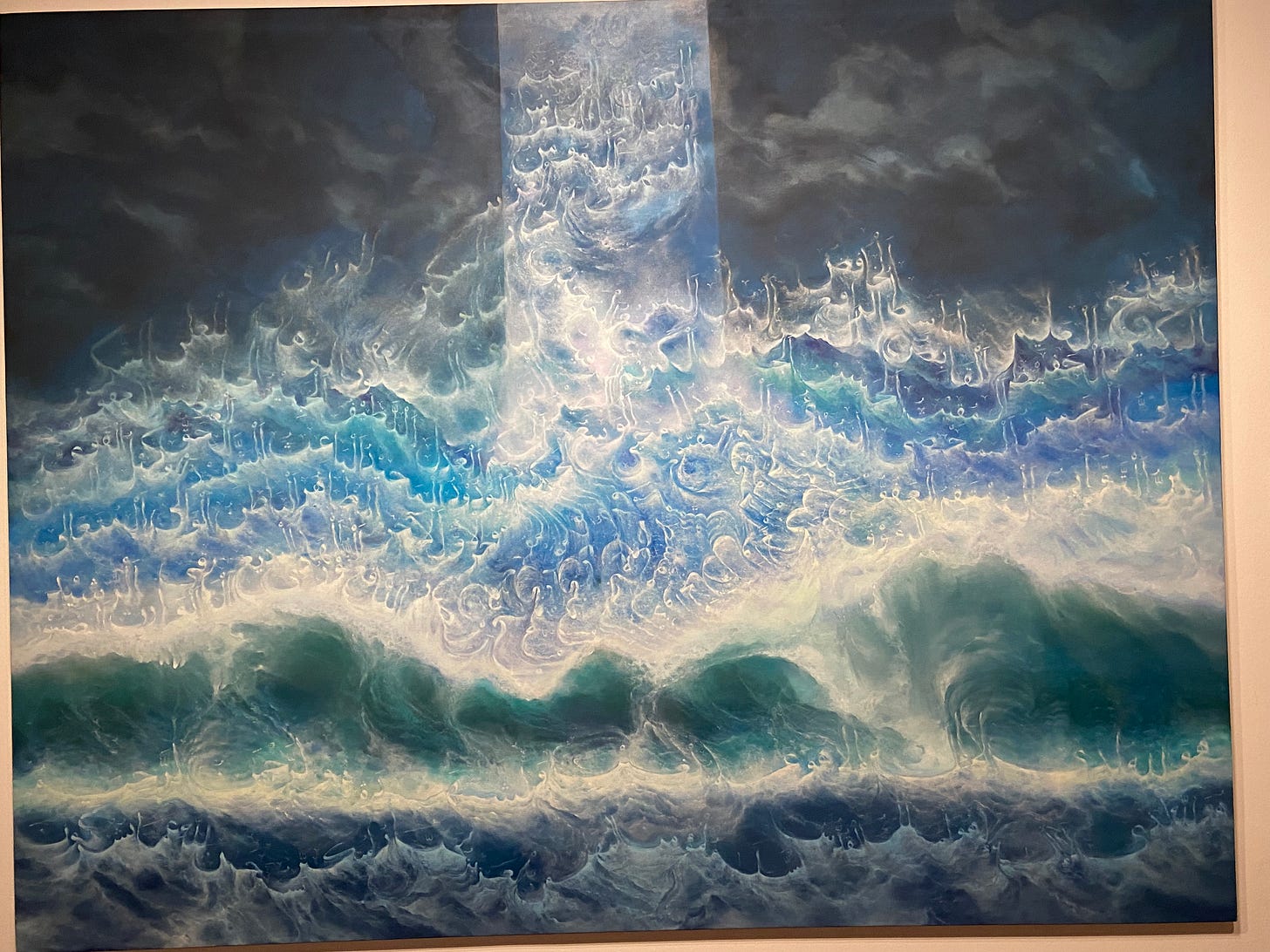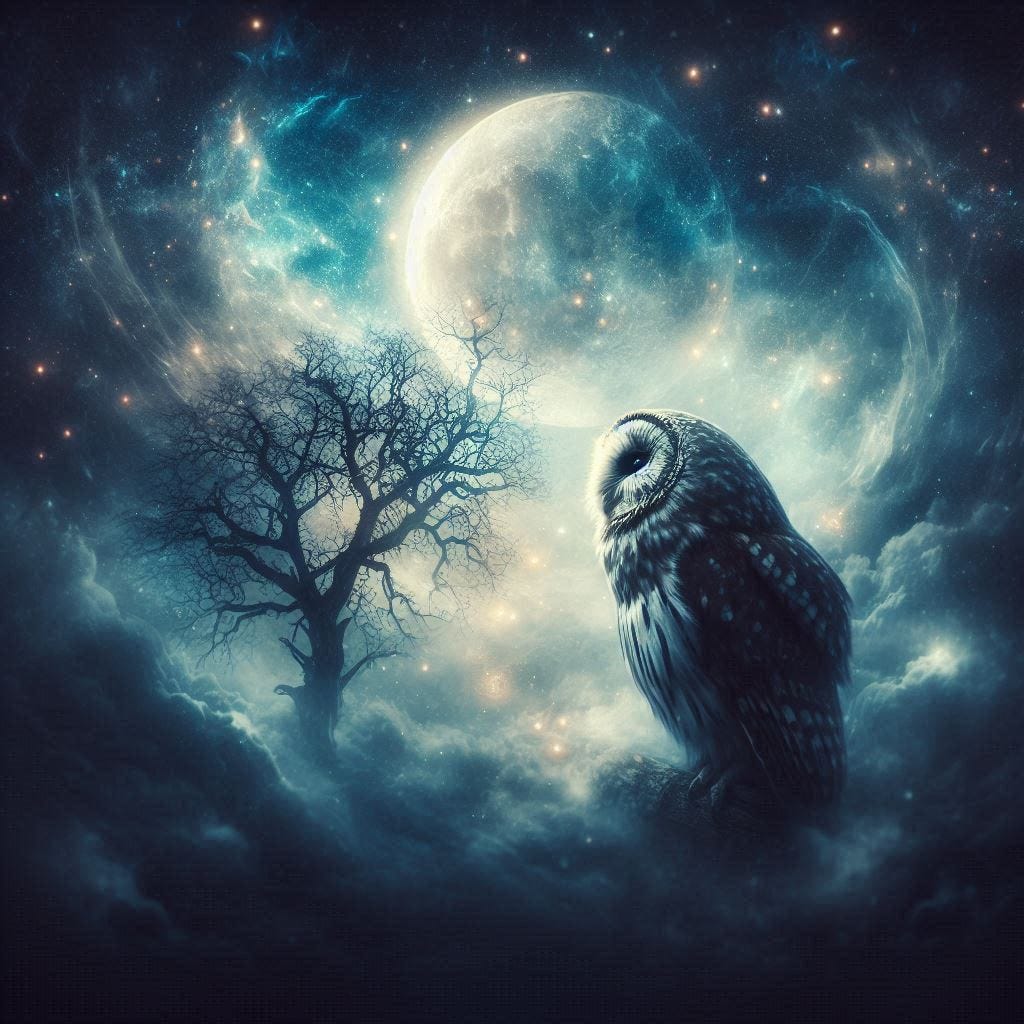Painting the phenomenology of longingness and mad love: Mastura's visual notes of Syair Burung Pungguk (Malay literary classic of 1865)
Early Review Notes by Azly Rahman
These notes below will form a forthcoming full-length essay on the work of Mastura Abdul Rahman, a series of paintings currently exhibited in Galeri Puteh, Kuala Lumpur (https://www.facebook.com/p/GALERI-PUTEH-100083099684174/)
Exhibition Invitation
Mastura Abdul Rahman's work revolves around the painting of select scenes via verses (rangkap-rangkap) from the writings of Ibrahim from Riau, who penned the classic Malay literature Syair Burung Pungguk. Through her iconic signature style, developed over 40 years, she has produced representations of the brown- hawk owl as it pines for the moon against the deep structure of Malay-Sufi philosophy, particularly one that grew out of the Johor-Riau culture.
An artist painting longingness
In her paintings, over the decades since she first won the Young Contemporary Artists Award soon after graduating from the then MARA Institute of Technology, she has explored the phenomena of harmony in the interiors of dwellings, hybridizing the influences of Malay traditional motifs with Persian miniature paintings. Prior to that, she was also chosen to participate, together with three other young artists, in the ASEAN Youth Painting Workshop and Exhibition in Jogjakarta. These early experiences immersed her in the deep play of Malay philosophy as it pertains to visual art.
She adds objects and symbolism from modern material culture and celebrates iconic traditional and legendary women leaders, such as Cik Siti Wan Kembang, through her research-based six paintings depicting the ancient kingdom of Kelantan, namely The Kingdom of Cik Siti Wan Kembang, the Wise Ruler. This work is called Taman Pesona, or The Enchanting Garden, loosely translated. In another series of work, Mastura honors her mother and reflects on what she learned during her growing-up years and beyond, as I narrated in an essay on her work, "Pesan Ibu/Mother's Reminder" (https://newswav.com/…/a-melancholic-painting-and-a…).
Additionally, she has worked with her students on painting homes in Kuala Perlis and now interprets scenes from the Malay syair of 1865, Syair Burung Pungguk. In all these endeavors, Mastura's focus has been to make the world aware of the beauty, intricacy, and spirituality of Malay culture, beyond how it is represented or misrepresented today. Her stewardship in the community art project in Perlis can be seen here: https://www.facebook.com/media/set/?vanity=studiopohonrendang&set=a.887178683439324&paipv=0&eav=AfaxjCmNpfkFPzj2vTzyiYncoy-V7ShkDpLMkG96tgC-9Iipe-3wwve0X1bX3b0SFuw&_rdr
Hence, her current series of work depicts the longing of the brown-hawk owl, burung pungguk, for the moon as a central theme in many Malay artistic representations of the complexity of love, longing, and belonging. Unrequited love is the theme, an existentialist notion of being human nonetheless, in which one needs to go through suffering (a Buddhist theme of living as well, samsara) in order to gain knowledge, understanding, and wisdom of the abstract and ideal world. The owl, metaphorically representing the ugliness of life and the imperfection of existence, should not succumb to suicide or self-destruction out of despair as the end of the story.
It is a symbol of the "self in search of the larger Self," as I see it. This is a Platonic notion of knowing and yearning to know, seeking to find meaning: the moon is the majestic abode of knowledge, too distant to be grasped by the gullible and error-prone human self. I see the theme embedded in Plato's doctrine of reminiscence, of the concrete in search of the abstract, of appearances and reality, of the imperfect and the ideal world.
A Longingness for Peace
Indeed, when conceptualizing this review essay, my mind was immersed in thinking about the absurdism of the conflict in the Middle East today, of the 40,000 Palestinians dead and Gaza and the West Bank reduced to rubble, just like the beautiful cities in Syria, Iraq, and Ukraine. I also think of the thousands of Israelis dead and kidnapped by Hamas on October 7, and the war looming between Iran and Israel as a consequence of the assassination of the leader of Hamas, who had vowed to destroy the nation and the state of Israel.
I think of longingness. Our longingness. For peace that may never come at all. Only destruction and more destruction. As if there is no divine will to stop it all. All left to human rationalism that has been long dead. Hence, Nietzsche’s complain.
What is there to long for in the chaos of wanting to destroy, as opposed to longing for the love of the Divine? Where is the sense of beauty in life and the search for it through the human yearning for perfection or to return to the creator in one piece, with consciousness and spiritual sensibility intact? Instead of returning with the body blown to pieces as a suicide bomber?
This is the contradiction of longingness I am still reflecting upon as I write this essay.
A song of longingness
While conceptualizing this essay, I thought of art forms, such as songs, that capture the notion of longing. I listened to songs by Malay artists such as Saloma, Sharifah Aini, and Siti Nurhaliza on the subject of pining. The imagery of the "burung pungguk," pining for the moon, came into play. Of course, there is the iconic image of P. Ramlee singing "Engkau Laksana Bulan," which also informed my cognitive-spiritual sensibility of what longing means as a phenomenon of the evolving self.
One pines for the impossible and the unreachable above, cursing at one's sorrowful self, created by God as such. The existentialist theme of despair and hopelessness, of dread and nihilism, with a Kierkegaard-Nietzsche proportion to it.
Consider the words:
Engkau laksana bulan
Tinggi di atas kayangan
Hatiku dah kau tawan
Hidupku tak keruan
O..o..o O..o..
Kau tinggalkan diriku
Oh! Tuhanku
Mengapakah
Kau bezakan hidupku
Oh! Tuhanku
Mengapakah
Manusia begitu
Mengapa ku di siksa
Mengapa kita bersua
Berjumpa dan bercinta
Tetapi menderita
[Engkau Laksana Bulan lyrics found on
http://lyrics.my
O..o..o O..o..
Kau tinggalkan diriku
(Kau cabutlah nyawaku)
Oh! Tuhanku
Mengapakah
Jadi miskin hidupku
Oh! Tuhanku
Mengapakah
Sangat buruk nasibku
Mengapa ku di siksa
Mengapa kita bersua
Berjumpa dan bercinta
Tetapi menderita
Drowned in the color of divine madness?
Longing, when translated into art, can have a paradoxical sensibility regarding the process and product. At what point does the artist, or painter in this case, become the object of his or her subjective experience, and how might "encounter or even immersion into the divine experience" be captured on canvas? In the process of composing, what is happening in the cognitive-spiritual realm of the painter?
Sometime around December of 2022, I was at the Balai Seni Visual Negara (Malaysian Visual Arts Gallery) in Malaysia with a painter who guided me through the painting "Asma Al Husna: Api, Air, dan Angin Seq 3" by a Kedah-born artist who, it seemed, after completing his work, took a 20-year hiatus (perhaps he could no longer paint) and was treated for mental illness. This story fascinated me when I think of the experience of the Sufi Mansur Al Hallaj, who was running around town screaming "Ana al Haqq, Ana al Haqq" (I am Truth, I am Truth) and was considered by the village folks to be a madman who had gone deranged, perhaps for being forced to encounter something profound that might have cured his illness of longing
.
A poem on longingness
Come taste the light
(lines composed while meditating upon a glass of light)
come one
come all
have a sip of a glow
from the glass of eternal spring of which life force flows
a traveler’s thirst we quench
in the desert heat the soul wrenches
come taste the glow of paradise
of the one only you and I know from birth till the day of our demise
from whence doth the force of life cometh?
one that dissolved the self in desire in all its warmth
did they not tell you wherein lies the tombs in you?
like karma, each day is a death, and life one sees
cometh forth anew?
I am eternal as finite as time unfolds
perish I will and in many forms I will manifest as limitless
as the oneness of my soul
exist I am as the word unspoken
in a multitude of layers of forms and substance I become a creation
the day is dark as a night unfolding
the glow of light in a glassful of souls a-rising
speak thou with words of silence that roars till the seventh heaven
so that thine may find the beauty of love glorious but unspoken
thou sees with thine eyes of unchallenged purity
the glow of the desert light as it canopies the chosen one
in a land of calamity
O' soul
who sees thou exist?
a paradox thou art
a traveler of samsara
a collapsing world of war and peace
verses flow in rhymes and rant
as if the soul in me a world of trees in unison they chant
in a deep forest of long ago we met
you and I, a love whose fate was all sealed
beautiful you are a glass of light
in darkness you reign
in all your might
in darkness you reside
Closing Notes
Mastura’s painting of the bird that pines — of the brown-hawk owl that will eventually die of despair, the melancholy of suffering in this Platonic world of illusion — is an interpretation of one of the most challenging question in life: what is worth living for, Waiting for? What does it mean to be free?
What then is the end goal of longingness? Union? Death and dissipation? Meeting of the self with the larger self? Of imperfection and Perfection?
I have mine. You have yours. In a world of multiple meanings.
But will what we long for be there when the story if over?
DR AZLY RAHMAN grew up in Johor Bahru, Malaysia and holds a Columbia University (New York City) doctorate in International Education Development and Masters degrees in six fields of study: Education, International Affairs, Peace Studies, Communication, Creative Non-Fiction, and Fiction Writing. He has written more than 500 analyses/essays on Malaysia. His 35 years of teaching experience in Malaysia and the United States spans over a wide range of subjects, from elementary to graduate education. He is a frequent contributor to scholarly online forums in Malaysia, the USA, Greece, and Montenegro. He writes at Substack and Linkedin
MY MEMOIR HERE: Grandma's Gangsta Chicken Curry and Gangsta Stories from My Hippie Sixties







